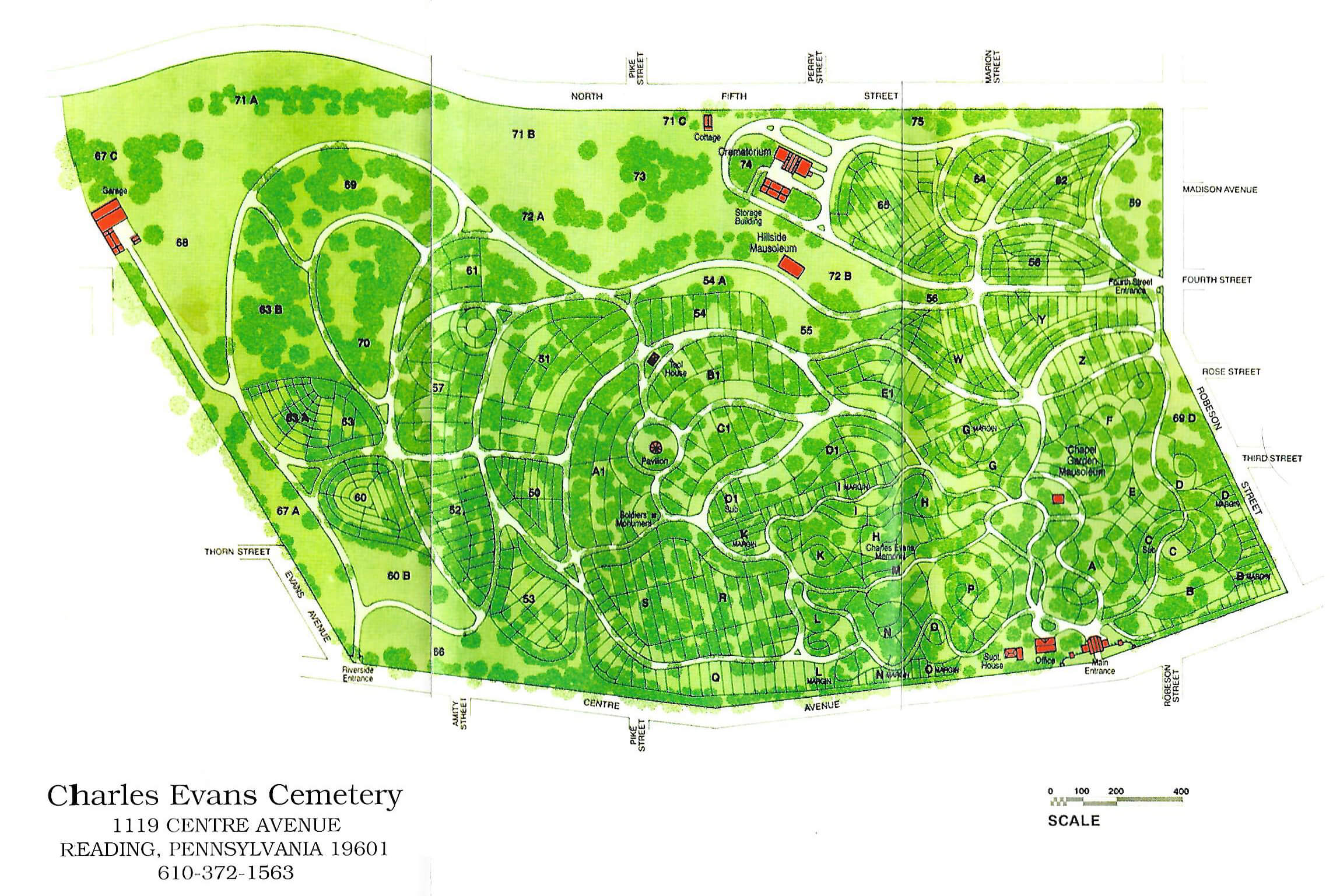Visitors are always welcome at Charles Evans.
An experienced, courteous attendant is on hand every weekday from 8 a.m. to 5 p.m. to personally guide you through the cemetery and various buildings.
Charles Evans Cemetery
1119 Centre Avenue
Reading, Pennsylvania 19601
Cevansgen@Gmail.com
T: (610) 372-1563
F: (610) 372-0126
Visit us on Facebook
To understand the historical importance of Charles Evans Cemetery, an examination of its context within the garden cemetery movement is required.
Prior to the advent of the non-sectarian garden cemetery movement, most Christian burials took place in church or denominational burial grounds. While these early public cemeteries were being established, there was a revolution in landscaping trends. The formal 18th Century estate gardens were giving way to a new movement – the romanticism of the 19th Century.
The highly controlled beds laid in formal grids or geometric patterns were replaced with more natural looking shapes and meandering paths winding among a lush variety of plants, shrubs, and shade trees. The romantic movement in landscaping encompassed public burial grounds, and thus the garden cemetery movement was born.
The importance of Charles Evans Cemetery as an early example of the public garden cemetery in the United States was established. Mount Auburn in Cambridge, Massachusetts, opened in 1831, served Boston and surrounding cities. Philadelphia’s Laurel Hill was the second garden cemetery, being incorporated by an act of the Pennsylvania legislature in 1836. Ten years later, Reading followed Philadelphia’s lead with Charles Evans Cemetery, incorporated with a similar act of the General Assembly in 1846.
Garden cemeteries, Charles Evans included, were used by the public not only for burial but also for the purposes of communing with nature and deceased loved ones. Sunday strolls through the beautiful grounds on pleasant days were standard for most families. It was not unusual to find entire families picnicking by a grave site. The garden cemetery evoked no ominous or morbid thoughts such as the old-fashioned church graveyard may have inspired.
The opening of a horse-drawn railway (trolley line) in 1874 made the Charles Evans Cemetery more accessible to the general public. Activities such as strolling the grounds increased but certainly did not extend to ball playing or more active forms of recreation.
In Reading, as elsewhere, it became evident that there was a need for public parks. Indeed, the garden cemetery movement is considered the forerunner of the public park movement.
You would have to travel far and wide in Pennsylvania to find a cemetery as well stocked with mature trees as Charles Evans. The serene, park-like atmosphere of the cemetery has much to do with the great variety of both native and exotic trees that are thriving throughout the grounds. The cemetery is graced by a wide range of tree species arranged in natural patterns among the grave stones, monuments and winding roads and paths. A leisurely drive or walk through the grounds will reveal trees as young as just a few years growing beneath giants that were planted over a century ago. The list of species growing in this arboretum in the city is extensive, boasting many types of native shade trees including oaks, maples, tulip-poplar, basswood, sycamore and pine as well as more exotic species like katsuratree and Japanese pagodatree. Every spring, a multitude of flowering dogwoods comes alive in a pink and white display unrivaled by any park in Berks County. Charles Evans has the distinction of possessing five trees which are listed as champions on the Pennsylvania Forestry Association’s Big Tree List – a Chinese catalpa, turkey oak, English yew, bigleaf linden and a lacebark elm.
A tree population of this size and diversity, in a public area hosting visitors every day of the week, needs to be well monitored and maintained to keep the trees safe, healthy and attractive. Trees are inspected frequently and routine maintenance performed, including removing dead limbs over roads and pathways, and elevation to provide clearance around monuments and open up vistas through the cemetery. It is also important to prune the youngest trees to train them into a structure that will require less attention in the future.
Over time, all trees become over mature, begin to decline and need to be removed. All removals are performed safely and competently by professional contractors, with the stumps ground out to allow for replacement. We plant new trees with the goal to favor mostly native species but also to diversify for balance and aesthetics and also to guard against damage due to possible future pest or disease outbreaks. New additions in recent years include swamp white oak, black gum, river birch, white fringetree, hackberry and even the American elm which has been absent from landscapes for decades due to Dutch Elm Disease.
Charles Evans Cemetery holds an amazing array of bird species. From raptor to warbler in type, and from resident to migratory are the reasons for being seen here.
What draws our avian friends to these 120 acres with approximately 7 miles of paved roads to walk is not a mystery. The elevation, though not the highest location of the County, is one of the highest in the City, and a significant contributing factor.
This habitat also harbors varied trees and shrubs as nest sites, protection, or rest stops along a migratory route. Flowering plants, rich earth and dead wood also act as an endless supply of food. The cycle of bird life is full with predator and prey species, and now becomes complete with you the observer.
Shaded cemeteries have always been productive places to bird and Charles Evans Cemetery is certainly no exception. The grounds and trees come alive with color and song in the spring and much continues throughout the other seasons. The setting always seems to bring peace to the soul but that symphony of bird songs and spectrum of colors soothes the heart and mind as well. Take time and find this magic for yourself.
This project of bird identification is the collective vision of Anna Marino-Hehn, artist/community activist; and Jack Holcomb, past president of the Baird Ornithological Club. They approached James C. Hart, cemetery superintendent with their idea and it won the approval by the Board of Trustees of Charles Evans Cemetery in June of 2009.


